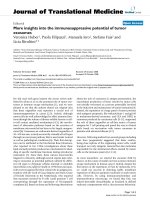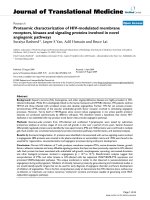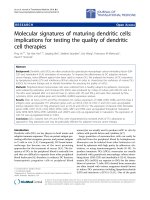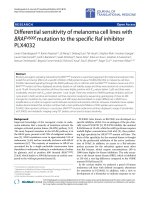Báo cáo hóa học: " Underlying reasons of the controversy over adverse effects of Bt toxins on lady beetle and lacewing larvae" potx
Bạn đang xem bản rút gọn của tài liệu. Xem và tải ngay bản đầy đủ của tài liệu tại đây (138.58 KB, 9 trang )
This Provisional PDF corresponds to the article as it appeared upon acceptance. Fully formatted
PDF and full text (HTML) versions will be made available soon.
Underlying reasons of the controversy over adverse effects of Bt toxins on lady
beetle and lacewing larvae
Environmental Sciences Europe 2012, 24:9 doi:10.1186/2190-4715-24-9
Angelika Hilbeck ()
Matthias Meier ()
Miluse Trtikova ()
ISSN 2190-4715
Article type Commentary
Submission date 30 December 2011
Acceptance date 15 February 2012
Publication date 15 February 2012
Article URL />This peer-reviewed article was published immediately upon acceptance. It can be downloaded,
printed and distributed freely for any purposes (see copyright notice below).
For information about publishing your research in Environmental Sciences Europe go to
/>For information about other SpringerOpen publications go to
Environmental Sciences Europe
© 2012 Hilbeck et al. ; licensee Springer.
This is an open access article distributed under the terms of the Creative Commons Attribution License ( />which permits unrestricted use, distribution, and reproduction in any medium, provided the original work is properly cited.
Underlying reasons of the controversy over adverse effects of Bt toxins on lady beetle
and lacewing larvae
Angelika Hilbeck*
1
, Matthias Meier
2
, and Miluse Trtikova
1
1
Institute of Integrative Biology, Swiss Federal Institute of Technology Zurich,
Universitätstrasse 16, Zurich, 8092, Switzerland
2
Research Institute of Organic Agriculture (FiBL), Ackerstrasse, Frick, 5070, Switzerland
*Corresponding author:
Email addresses:
AH:
MM:
MT:
Abstract
We outline important underlying reasons that fuel the decades-long controversy over adverse
effects of Bt toxins expressed in genetically modified plants on beneficial, nontarget
organisms. Inconsistent evaluation standards and asymmetrical levels of scrutiny applied to
studies reporting significant adverse effects compared to those finding no adverse effects are
described using the examples of the green lacewing (Chrysoperla carnea) and the two-spotted
lady beetle (Adalia bipunctata). Additionally, the chosen style and concerted nature of the
rather confrontational counter study and responses in the lady beetle cases bear striking
similarities to other reported examples in the field of biosafety/risk science of genetically
modified plants and to other fields of applied industrial techno-science that suggest deeper
issues that go well beyond science. We call for a constructive and respectful scientific
discourse where moving the frontiers of our collective knowledge forward takes center stage.
Reported phenomena based on robust data must not be rejected or delegitimized on their
being surprising and lacking an explained mechanism at the time of their discovery. Exploring
mechanisms often requires entirely different expertise and methodologies than those of the
discoverers. In particular, in biosafety/risk sciences, plurality of arguments and critical
research approaches have to be embraced and actively encouraged rather than discredited or
even silenced if we are to learn our ‘late lessons’ from past technology introductions.
In 2008/2009, Schmidt and colleagues [1] published a study reporting lethal effects of the
microbial Bt toxins Cry1Ab and Cry3Bb on the biological control organisms Adalia
bipunctata, a lady beetle. Based on this study and in concert with at least 30 other
publications, Mon810 cultivation was banned in Germany in 2009. This policy response
triggered two commentaries and one experimental study all published in the journal
Transgenic Research that question the scientific basis of the German ban or claim to disprove
the adverse effects of the Bt toxins on A. bipunctata reported by Schmidt and colleagues,
respectively [2-4]. In a parallel paper, we report new data of a study that was undertaken to
investigate the underlying reasons for the different outcomes and rebut some of the scientific
aspects of the criticism voiced in the three publications. Here, we wish to take the opportunity
to comment on some broader scientific aspects and issues that go beyond the experimental
science delivered in the parallel paper. Given the strong language and the seemingly
concerted effort we were confronted with in these three counter papers and, of course, in
blogs and other fora, we find it justified, even necessary to, at least once, offer our evaluation
and position on these criticisms.
In principle, we welcome the fact that our studies continue to stimulate debate and
occasionally more research. However, it is unfortunate that the study by Alvarez-Alfageme et
al. [2] was apparently set up primarily with the aim of disproving the results reported by
Schmidt et al. [1]. Of course, any science has to withstand attempts at falsification just as any
research result stands until new data emerges, pushing the frontiers of knowledge forward.
However, the uncalled for, unnecessarily confrontational, and at times rather disrespectful
unscientific nature of the language chosen obviously indicates deeper underlying issues. Other
such confrontational responses and deliberate counter studies come to mind, as for example,
the decades-long controversies on the risks connected with smoking, asbestos, or currently
on-going bisphenol A and mobile telephones, where ‘manufacturing uncertainty’ has been
well researched and documented, for example, by Michaels and Morforton [5]. We cannot
know at present whether similar motivations drive the dogmatic ‘refutations’ which we find
with respect to peer-reviewed results on potential harm from genetically modified organisms
[GMOs], but reason alone forces one to wonder about this. More past examples of ‘shooting
the messenger’ styles of responses following the publication of inconvenient research can also
be found in the Late Lessons from Early Warnings: The Precautionary Principle 1896-2000
published by the European Environment Agency [6], which in hindsight clearly generated a
lot of unnecessary damage and avoidable human suffering. Indeed, here is a striking precedent
of a previous case as well, as Rauschen [3] also notes in his opinion piece but for other
reasons. Similar counter studies were launched to disprove the reporting of adverse effects of
Bt toxins on another predatory species, the green lacewing (Chrysoperla carnea), roughly 10
years ago. We argue that, in addition to the mentioned argument, double standards and
asymmetrical levels of scrutiny are being applied to studies reporting adverse effects of Bt
toxins expressed in genetically modified [GM] crops on nontarget organisms that continue to
fuel the debate. In the following paragraphs, these points are explained and supporting
evidence is provided.
Double standards: debated routes of ingestion/exposure. The green lacewing, another
important biological control organism, is also routinely tested for nontarget effects of Bt
toxins for regulatory purposes in the approval process of Bt plants. The testing protocol
follows closely the one used for pesticide testing which is based on the use of meal moth eggs
that are coated with the test substance. Pesticides are externally applied on plants and insects
and are often poisons that are taken up via skin or trachea (breathing apparatus) which is how
they exert their effect. Bt toxins are gut poisons that must be ingested to unfold their effects. It
is largely undisputed and has been pointed out for many years that the larvae of C. carnea are
truly incapable of ingesting compounds deposited on the exterior of the eggs due to their very
distinct, strictly piercing-sucking mouthparts (see Figure 1 for comparison of the mouthparts
of C. carnea and A. bipunctata). We were among the first to point this out and express our
concern about the inappropriateness of using coated meal moth eggs for testing Bt toxins [7].
To our knowledge, no comparable criticism has been published or voiced by the authors of
the three papers discussed here regarding these obvious shortcomings in such trials that
represent the prime data basis for safety assessments of Bt crops in the regulatory approval
process. On the contrary, when we published our studies a decade ago revealing these
shortcomings for green lacewing larvae and documenting that Bt toxins - both of microbial
origin and of plant-origin - caused significant lethal effects in green lacewing larvae when
administered directly or via prey into their gut using a protocol that ensured ingestion [7-9],
they triggered a strikingly similar response involving some of the same authors of the
Alvarez-Alfageme et al. paper [2]. Studies were published claiming to disprove the lethal
effects of Bt toxins on C. carnea [10-12]. Also for this case, the differences in outcomes could
be explained by the substantial differences in applied protocols and parameters measured [13],
some of which bear resemblance to the protocols applied in this case of A. bipunctata (e.g.,
use of sugar solution and shorter exposure times). Rauschen [3] fails to acknowledge these
pertinent issues when making reference to the green lacewing case. It is, however, quite
interesting to note that the realization of the shortcomings we have been pointing out has at
least been trickling into the regulatory requirements of the US Environmental Protection
Agency [EPA]. This scientific deficiency is recognized in rulings like the following statement
from 2007: ‘In addition, it is questionable whether the green lacewings are ingesting the
CryBb1 protein that is coated around moth eggs in a diet. Since green lacewings have
piercing-sucking mouthparts, they may not be exposed to the protein on the external surface
of the egg diet’ [14]. However, instead of recommending tests with altered protocols that
ensure ingestion of the Bt toxin, EPA recommends to drop this testing organism altogether
and use instead another predator of the genus Orius [14] that has already been demonstrated
not to be sensitive to Bt toxins (e.g., [15]). In addition, regarding lady beetles that are also
routinely tested in safety trials for the regulatory approval of Bt crops, these were and still are
often tested during the adult stage, which is inappropriate. It is undisputed that Bt toxins are
gut toxins that exert their maximum effect during the juvenile stages of an insect. This
shortcoming has also been recognized only years after the first commercial approvals by the
EPA: ‘EPA also believes, however, that lady beetle larvae would potentially have a higher
risk of exposure to Cry2Ab2 than adults. Therefore, a dietary toxicity study will be required to
determine the no observed effect concentration for lady beetle larvae.… EPA has not
previously required such a lady beetle larvae study for other registered PIP products…’ [16].
For more details on these and other shortcomings in testing procedures for regulatory
biosafety purposes of GM crops, we refer to an extended review by Dolezel et al. [17].
None of these obvious and recognized deficiencies led the authors of the three papers
discussed here [1, 3, 4], nor the European Food Safety Agency [EFSA] for that matter, to
apply a similar level of critical scrutiny as they have applied to Schmidt et al. [1] and other
studies reporting adverse effects, when they deal with these regulatory biosafety studies that
constitute the core data basis for regulatory approvals.
Level of scrutiny. The above-described double standards reinforce the longstanding
observation that in the GMO environmental risk assessment field, often only those studies that
report adverse effects are subjected to ‘extra’ scrutiny by the regulatory science community
and some scientist circles including the authors of the three papers discussed here. This
practice has also been applied by EFSA and was confirmed in an interview with a former
EFSA GMO panel member who stated: ‘Of course, studies that describe potential negative
environmental effects of GMOs are discussed particularly intensively’ [18]. According to
Millstone et al. [19], this practice is interpreted by the European public as an illegitimate
support for the biotechnology industry, by the risk assessor. They state that ‘greater
institutional care was taken to try to avoid false positives than to avoid false negatives. That
implies that critical scrutiny has been applied in an asymmetrical fashion that prima facie
seems difficult to reconcile with a precautionary approach’ [19]. The European Commission
does indeed claim to follow the precautionary principle in all its regulatory appraisal
processes.
Choice of language and displayed attitude. Lastly, we cannot help but also notice the striking
resemblance of the three concerted papers discussed here to the strategy extensively
documented and described by Waltz [20] in her Nature article and summarized as follows:
‘Papers suggesting that biotech crops might harm the environment attract a hail of abuse from
other scientists. Behind the attacks are scientists who are determined to prevent papers they
deem to have scientific flaws from influencing policy-makers. When a paper comes out in
which they see problems, they react quickly, criticize the work in public forums, write rebuttal
letters, and send them to policy-makers, funding agencies and journal editors.’ We also find
confirmation for the observation of an editor of the scientific journal Environmental
Entomology after having been subjected to a similar ordeal with another ‘problem paper’ who
states that ‘part of what exasperates me is that they (the attacking scientists) have declared
themselves to be the experts in this field and forcefully present themselves as the ultimate
arbiters of truth’ [20]. There is ample evidence for such a self-acclaimed ‘arbiters of truth’
attitude displayed ‘forcefully’ in all three publications [1, 3, 4]. As we find in particular those
by Alvarez-Alfageme et al. [1] and Rauschen [3] unscientific, disrespectful, and thus,
unacceptable for a proper scientific discourse, we do not repeat them here but refer to the
original sources which also reflect on their preferred chosen outlet, the journal Transgenic
Research. Needless to say that none of the attacked authors of the Schmidt et al. [1] study
were informed prior to the publication of the three papers let alone offered the opportunity to
defend and/or clarify their research, in response. This is one way a debate can be conducted
but clearly not a constructive nor a properly scientific one at all. We hope that with both the
scientific content of our follow-up study and the tone of this commentary, we have succeeded
in setting a higher standard for scientific disagreement that aims to generate more and better
knowledge, whichever way it may point in policy terms, rather than a more confrontational
dogma. Better standards also include that at some point, one has to stand up to those who are
not adhering to a common proper code of conduct and to reveal exactly that.
Scientists concerned with the environmental risks of novel technologies ought not to dismiss
new knowledge/phenomena and delegitimize unexpected results based on their being
‘surprising’ and lacking an explanatory mechanism at the time of discovery, or possibly
triggering policy responses one happens to disagree with. Scientific progress often comes
about by first discovering and reporting an unexpected and inexplicable novel phenomenon.
Only if that phenomenon is deemed of sufficient curiosity and importance do we embark on
exploring the underlying mechanisms. More often than not, this requires entirely different
expertise and techniques than those of the discoverers. It is indisputable that the lack of an
explanatory mechanism does not - or rather, should not - invalidate an empirically established
phenomenon. We have repeatedly established the phenomenon that Bt toxins can induce a
significantly higher mortality in the two nontarget beneficial insects, green lacewings and the
lady beetle A.bipunctata, with scientific data which are among the statistically and
methodologically most robust that are published on this issue in the scientific literature to date
(see the parallel paper to this commentary and Hilbeck and Schmidt [13] for extensive
comparison of the statistical values and experimental methodologies). It is time to move
beyond this dogmatic denial and ‘killing the messenger’ stage of the debate. Researchers with
other expertise are now called upon to engage in research that genuinely aims at studying and
elucidating the mechanisms of this established phenomenon and push forward our knowledge
on modes of action of Bt toxins and modes of interaction (e.g., [21]) with other cofactors
(e.g., [22]). After all, an increasing number of so-called ‘stacked’ Bt plants are reaching our
fields and markets today that contain up to six Bt toxins, and hardly any of which have been
tested for their combinatorial effects due to the ‘lack of a known mechanism’. We find this a
non-precautionary and insufficient scientific reason for simply foregoing the expenditure of
testing, and perhaps even more importantly, possibly finding potential adverse effects, and
thus, being able to prevent them.
Competing interests
The authors declare that they have no competing interests.
Authors' contributions
AH wrote the commentary. AH, together with MM and MT and along with the inspiration
from numerous colleagues far beyond the circle of authors of this and the parallel science
article, discussed and developed the arguments. All authors read and approved the final
manuscript.
References
1. Schmidt JEU, Braun CU, Whitehouse LP, Hilbeck A: Effects of activated Bt
transgene products (Cry1Ab, Cry3Bb) on immature stages of the ladybird Adalia
bipunctata in laboratory ecotoxicity testing. Arch Environ Contam Toxicol 2009,
56:221-228.
2. Alvarez-Alfageme F, Bigler F, Romeis J: Laboratory toxicity studies demonstrating
no adverse effects of Cry1Ab and Cry3Bb1 to larvae of Adalia bipunctata
(Coleoptera: Coccinellidae): the importance of study design. Transgenic Res 2010,
20:467-479.
3. Rauschen S: A case of 'pseudo science'? A study claiming effects of the Cry1Ab
protein on larvae of the two-spotted ladybird is reminiscent of the case of the
green lacewing. Transgenic Res 2010, 19:13-16.
4. Ricroch A, Bergé JB, Kuntz M: Is the German suspension of Mon810 maize
cultivation scientifically justified? Transgenic Res 2010, 19:1-12.
5. Michaels D, Morforton C: Manufacturing uncertainty: contested science and the
protection of public’s health and environment. Am J Publ Health 2005, 95:39-48.
6. European Environment Agency: Late Lessons from Early Warnings: The
Precautionary Principle 1896-2000. Environmental Issue Report. Copenhagen: 2001.
7. Hilbeck A, Moar W, Pusztai-Carey M, Filipini A, Bigler F: Toxicity of Bacillus
thuringiensis Cry1Ab toxin to the predator Chrysoperla carnea (Neuroptera:
Chrysopidae). Environ Entomol 1998, 27:1255-1263.
8. Hilbeck A, Moar W, Pusztai-Carey M, Filipini A, Bigler F: Prey-mediated effects of
Cry1Ab toxin and protoxin and Cry2A protoxin on the predator Chrysoperla
carnea (Neuroptera: Chrysopidae). Entomol Exp Appl 1999, 91:305-316.
9. Hilbeck A, Baumgartner M, Fried PM, Bigler F: Effects of transgenic Bt corn-fed
prey on immature development of Chrysoperla carnea (Neuroptera:
Chrysopidae). Environ Entomol 1998, 27:480-487.
10. Dutton A, Klein H, Romeis J, Bigler F: Uptake of Bt-toxin by herbivores feeding on
transgenic maize and consequences for the predator Chrysoperla carnea. Ecol
Entomol 2002, 27:441-447.
11. Dutton A, Klein H, Romeis J, Bigler F: Prey-mediated effects of Bacillus
thuringiensis spray on the predator Chrysoperla carnea in maize. Biol Contr 2003,
26:209-215.
12. Romeis J, Dutton A, Bigler F: Bacillus thuringiensis toxin (Cry1Ab) has no direct
effect on larvae of the green lacewing Chrysoperla carnea (Stephens)
(Neuroptera: Chrysopidae). J Insect Physiol 2004, 50:175-183.
13. Hilbeck A, Schmidt JEU: Another view on Bt-proteins - how specific are they and
what else might they do? Biopesticides Int 2006, 2:1-50.
14. US Environmental Protection Agency Office of Pesticide Programs: Bt Cry3Bb1
corn biopesticide registration action document.
[
15. Zwahlen C, Nentwig W, Bigler F, Hilbeck A: Tritrophic interactions of transgenic
Bacillus thuringiensis corn, Anaphothrips obscurus (Thysanoptera: Thripidae),
and the predator Orius majuscules (Heteroptera: Anthocoridae). Environ Entomol
2000, 29:846-850.
16. US Environmental Protection Agency Office of Pesticide Programs: Biopesticides
registration action document. Bacillus thuringiensis Cry2Ab2 protein and its
genetic material necessary for its production in cotton.
[
17. Dolezel M, Miklau M, Hilbeck A, Otto M, Eckerstorfer M, Heisenberger A, Tappeser
B, Gaugitsch H: Scrutinizing the current practice of the environmental risk
assessment of GM maize applications for cultivation in the EU. Environ Sci Eur
2011, 23:33.
18. EFSA: New Members for GMO Panel. [ />members-gmo-panel.html]
19. Millstone E, van Zwanenberg P, Marris C, Levidow L, Torgersen H: Science in Trade
Disputes Related to Potential Risks: Comparative Case Studies. Seville: European
Commission; 2004.
20. Waltz E: Battlefields. Nature 2009, 461:27-32.
21. Graf J: Shifting paradigm on Bacillus thuringiensis toxin and a natural model for
Enterococcus faecalis septicaemia. mBio 2011, doi:10.1128/mBio.00161-11.
22. Then C: Risk assessment of toxins derived from Bacillus thuringiensis –
synergism, efficacy, and selectivity. EnvironSci Pollut Res 2010, 17:791-797.
Figure 1. Pictures of mouth parts of first instar larvae. (a) Chrysoperla carnea (strictly
piercing-sucking) and (b) Adalia bipunctata (biting, licking).
a) b)
Figure 1









